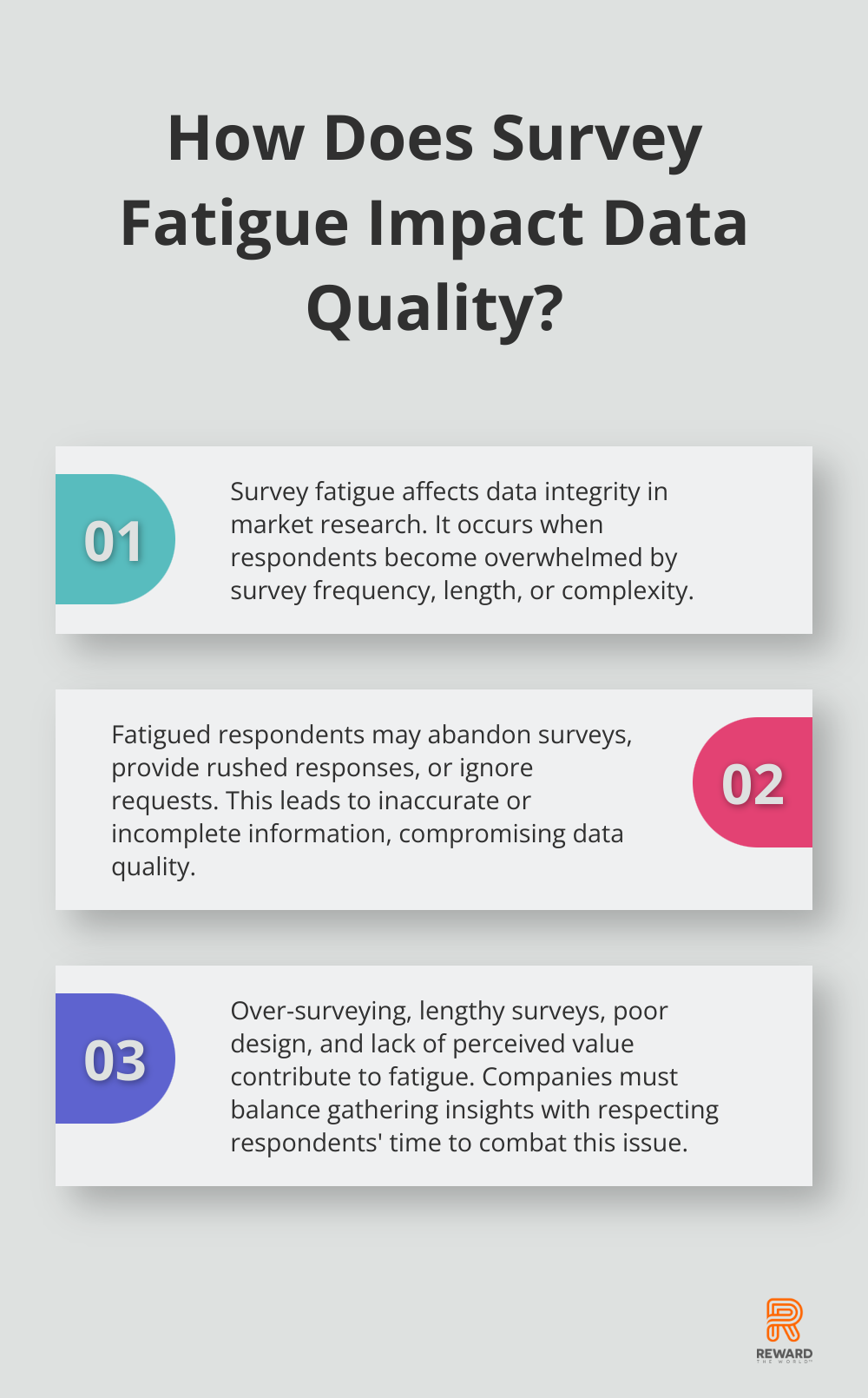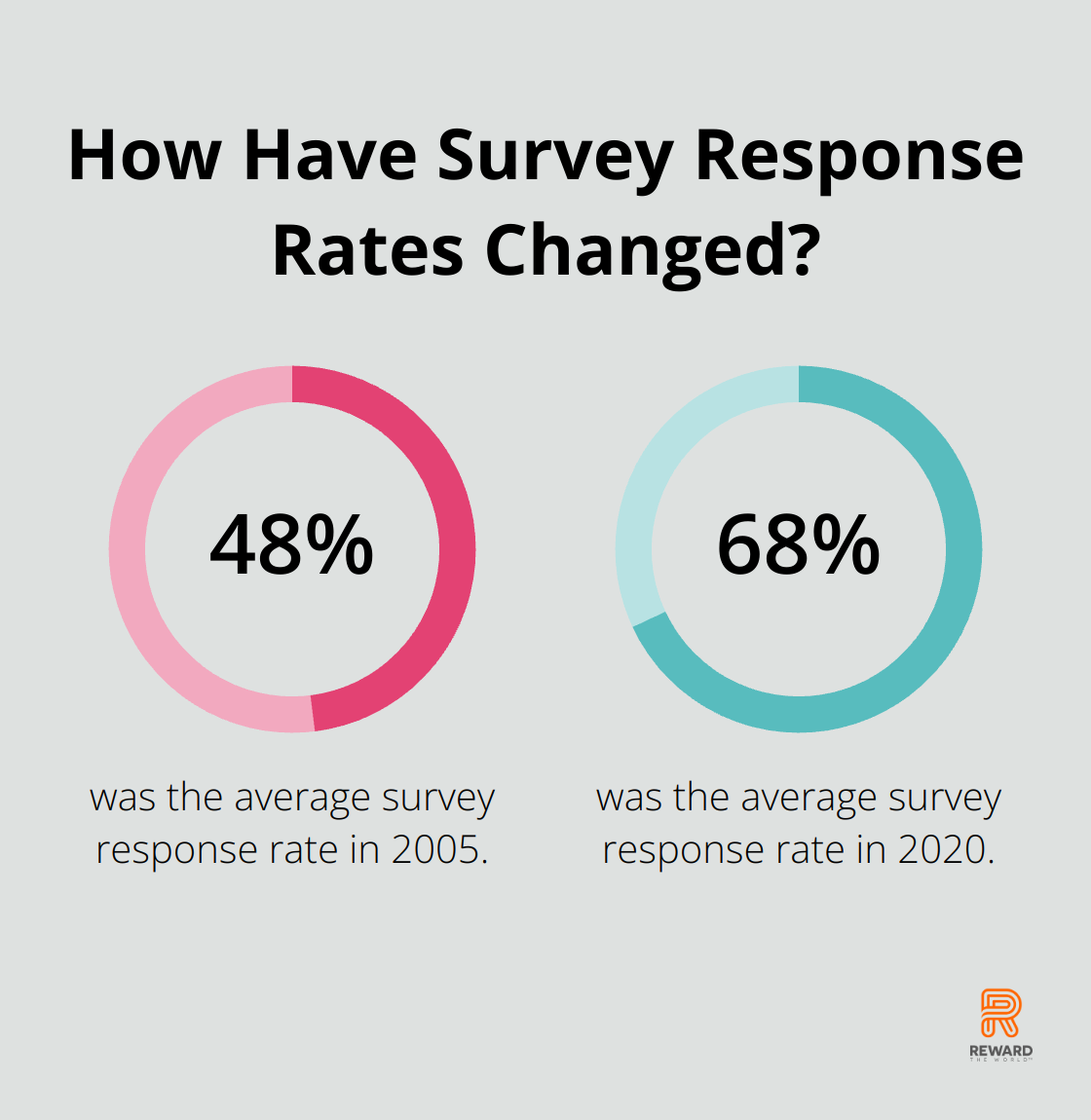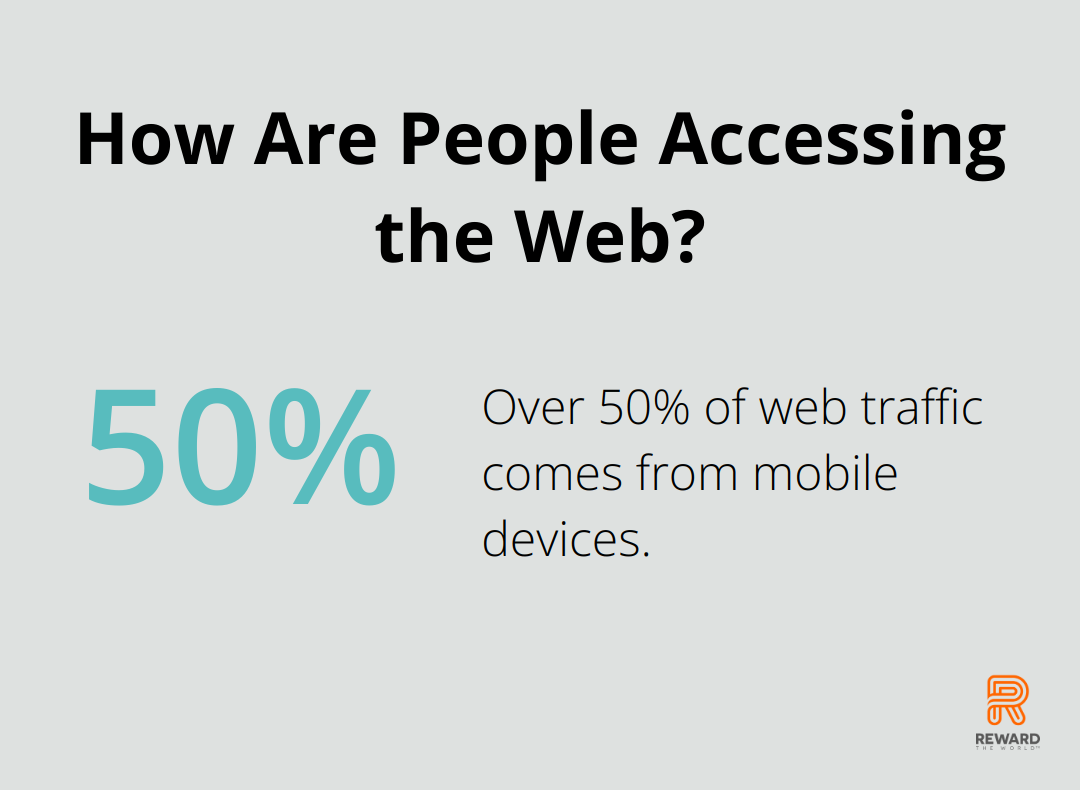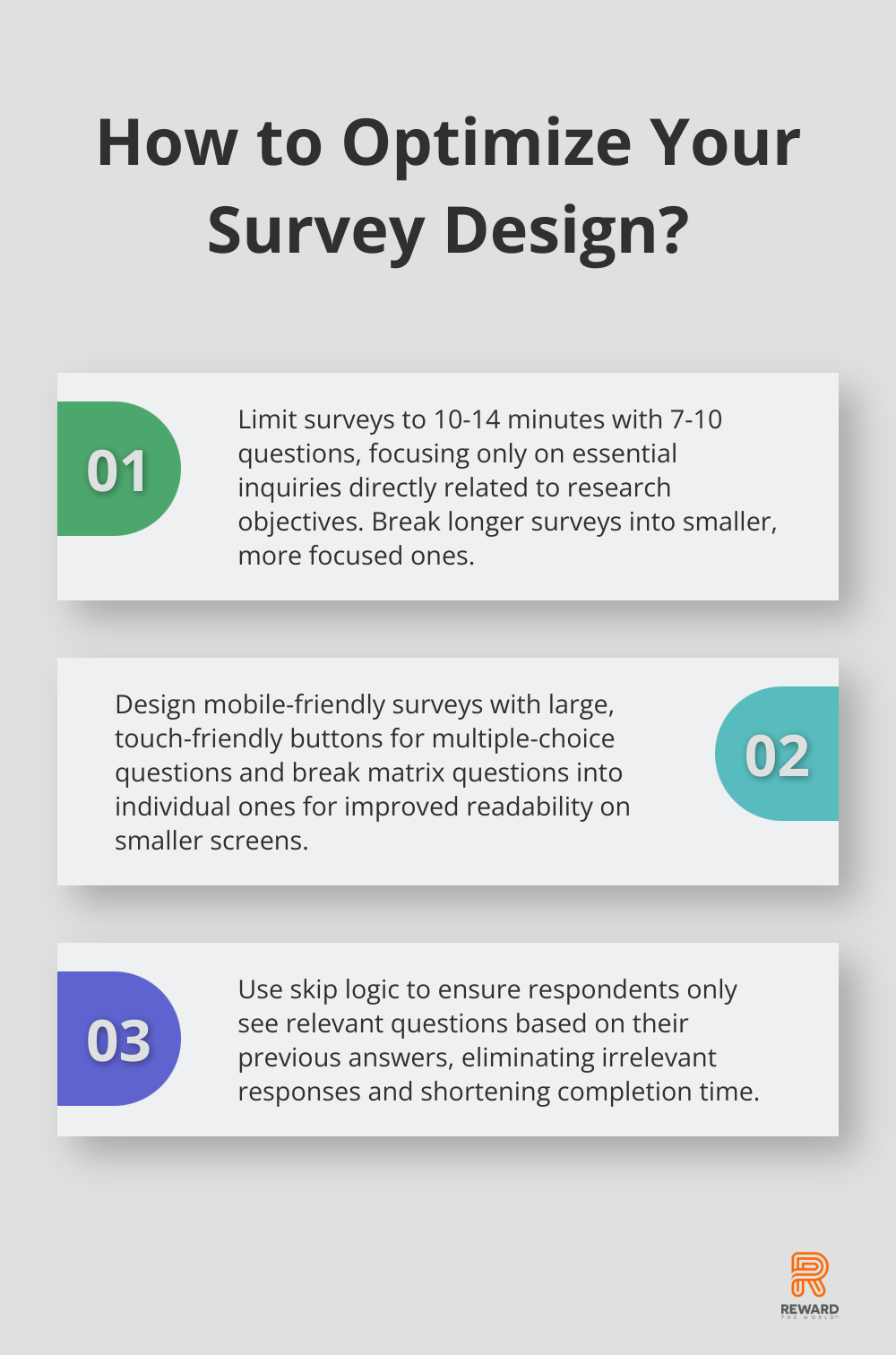
Survey fatigue is a growing challenge in market research, threatening the quality of data and response rates.
At Reward the World, we’ve seen firsthand how this issue can impact businesses and their decision-making processes.
In this post, we’ll explore effective strategies to combat survey fatigue, from innovative incentive programs to smart survey design techniques.
What Is Survey Fatigue?
The Definition and Impact of Survey Fatigue
Survey fatigue is a widespread issue in market research that affects various industries. It occurs when respondents become overwhelmed by the frequency, length, or complexity of surveys. This fatigue is characterized by prospective survey respondents’ reluctance to participate and can significantly impact data integrity and business decisions.
Recognizing the Signs
Survey fatigue manifests in several ways:
- Abandonment: Respondents leave surveys before completion.
- Rushed Responses: Participants provide hasty or inconsistent answers.
- Ignoring Requests: People simply disregard survey invitations.

A SurveyMonkey study revealed that respondents are less likely to experience survey fatigue and get frustrated in their survey-taking process when using appropriate survey design techniques.
The Data Quality Dilemma
The impact of survey fatigue on data quality is substantial. Fatigued respondents often provide inaccurate or incomplete information, which compromises the integrity of collected data. This can lead to misguided business decisions (a risk no company wants to take).
Root Causes of Survey Burnout
Several factors contribute to survey fatigue:
- Over-surveying: Many companies bombard customers with feedback requests after every interaction.
- Lengthy Surveys: Long surveys can quickly exhaust respondents.
- Poor Design: Confusing questions or repetitive content quickly exhaust respondents.
- Lack of Perceived Value: Not knowing how their input was used discourages future engagement.
The Balance Between Insight and Respect
To combat survey fatigue effectively, companies must balance gathering necessary insights with respecting respondents’ time and effort. This involves careful consideration of survey frequency, length, and design. Implementing a strategic approach to survey distribution and offering meaningful incentives can significantly mitigate fatigue and improve response rates.
As we move forward, we’ll explore effective incentive strategies that can help combat survey fatigue and keep respondents engaged. These strategies (when implemented correctly) can transform the survey experience from a chore into a rewarding interaction.
How Can Incentives Combat Survey Fatigue?
The Power of Monetary Incentives
Cash rewards, gift cards, and points systems motivate survey participants effectively. A study showed a steady increase in average response rates from 48% in 2005 to 68% in 2020, demonstrating the significant impact that incentives can have on survey participation.

For instance, a tech company saw an increase in survey completion rates when it offered gift cards for a 15-minute survey. This approach not only boosted participation but also improved the quality of responses.
Beyond Money: Non-Monetary Incentives That Work
While monetary rewards prove effective, non-monetary incentives can be equally powerful. Exclusive content, early access to products, or public recognition appeal to different motivations.
A study found that non-monetary incentives like shopping vouchers are commonly used to improve survey response, but it has little to no impact on the survey rate.
Tailoring Incentives to Your Audience
One size doesn’t fit all when it comes to incentives. Understanding your target demographics is essential for selecting the most effective rewards.
For example, a gaming company found that offering in-game currency as an incentive was effective for their younger audience. Meanwhile, a B2B software company saw results with professional development resources as incentives for their corporate clients.
The Timing and Presentation of Incentives
How and when you present incentives can significantly impact their effectiveness. Clear communication of the reward at the beginning of the survey can increase start rates, while promising the incentive upon completion can boost finish rates.
A retail chain experimented with different incentive presentations. They found that mentioning a chance to win a prize in the survey invitation increased open rates, compared to a generic “your feedback is important” message.
Balancing Incentives and Data Quality
The goal is not just to get more responses, but to get quality data. Strategic use of incentives can combat survey fatigue, increase participation, and ultimately gather more valuable insights for your business. However, it’s important to strike a balance (incentives should motivate participation without biasing responses).
Careful planning of your survey timing and frequency can significantly reduce survey fatigue while still gathering the insights you need.
As we move forward, we’ll explore how survey design itself can play a crucial role in minimizing fatigue and maximizing engagement, complementing the power of well-chosen incentives.
How Survey Design Minimizes Fatigue
Keep It Short and Sweet
The length of your survey directly impacts completion rates. For most surveys, the perfect length is 10-14 minutes, with customers willing to answer 7-10 questions at a time. Try to create surveys that align with these guidelines.

To achieve this, focus on essential questions that directly relate to your research objectives. Eliminate any redundant or nice-to-have questions. If you find yourself with a longer survey, consider breaking it into smaller, more focused surveys.
Choose the Right Question Types
The types of questions you ask can significantly impact survey fatigue. Closed-ended questions (like multiple choice or rating scales) are generally quicker and easier for respondents to answer. However, a mix of question types can keep the survey interesting.
Start with simple multiple-choice questions to ease respondents in. Use Likert scales for opinion-based questions, and save open-ended questions for when you need detailed insights. Limit open-ended questions to 2-3 per survey to prevent fatigue.
Optimize for Mobile
With over 50% of web traffic coming from mobile devices, mobile-friendly surveys are non-negotiable. Designing surveys for mobile phones requires careful consideration to ensure they are practical, engaging, and yield high-quality data.
Ensure your survey platform automatically adjusts to different screen sizes. Use large, touch-friendly buttons for multiple-choice questions. Break matrix questions into individual questions on mobile to improve readability.
Personalize the Experience
Personalization can significantly boost engagement and reduce fatigue. Use the data you already have about your respondents to tailor the survey experience. This could be as simple as addressing the respondent by name or as complex as skipping irrelevant questions based on previous responses.
If you’re surveying customers about a recent purchase, reference the specific product they bought. This shows respondents that you value their individual experience and aren’t just sending out generic surveys.
Make It Relevant
Irrelevant questions quickly induce survey fatigue. Use skip logic to ensure respondents only see questions that apply to them. This not only reduces fatigue but also improves data quality by eliminating irrelevant responses and shortening the completion time.
For instance, if a respondent indicates they don’t own a car, skip all questions related to car ownership. This respect for the respondent’s time can lead to higher completion rates and more accurate data.
Final Thoughts
Survey fatigue poses a significant challenge in market research, but effective strategies can overcome it. Strategic incentives and thoughtful survey design maintain high-quality data collection while respecting respondents’ time and effort. Short, relevant, and mobile-optimized surveys that offer a personalized experience reduce fatigue and boost engagement.

The future of market research will focus on respondent-centric approaches, including AI-driven personalization and seamless digital integration. Innovative methods to demonstrate the impact of participant feedback will become increasingly important. These trends will shape how businesses gather insights while fostering positive relationships with respondents.
Reward the World offers a comprehensive solution that combines powerful incentives with user-friendly survey tools. Our platform helps businesses combat survey fatigue (ensuring high-quality data collection). The key to success in market research lies in balancing insight gathering with participant respect, unlocking the full potential of research efforts.
